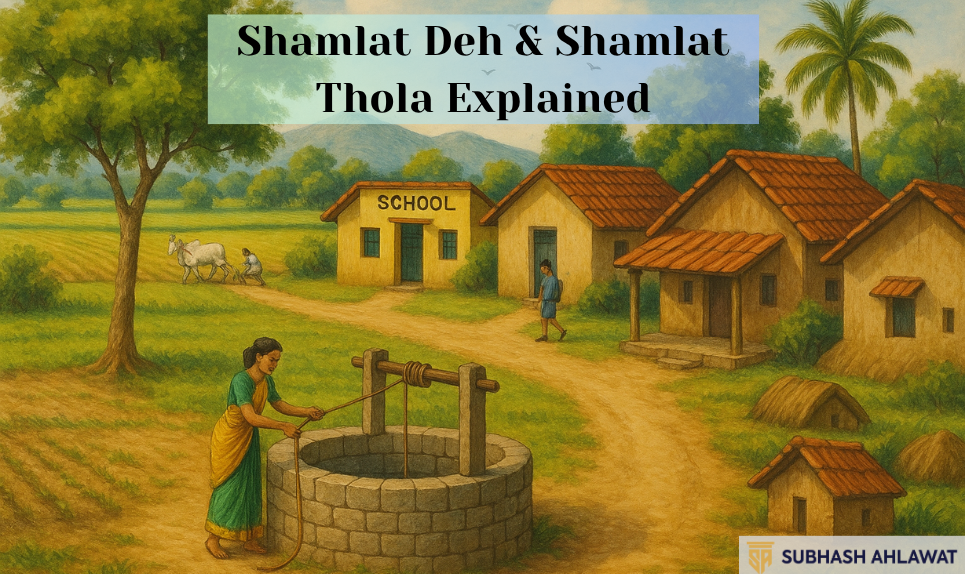Shamlat Deh & Shamlat Thola Explained

Across North India—especially in the present-day States of Punjab, Haryana, Himachal Pradesh and parts of Delhi—rural revenue records still carry two intriguing labels: “Shamlat Deh” and “Shamlat Thola.” Both phrases describe common lands, but they trace different lines of history and convey different bundles of rights. Understanding those distinctions is vital for lawyers, village panchayats, developers, and families who hope to build, farm, or litigate on such parcels.
Origins and Historical Context
During the Mughal period, villages maintained a pool of grazing grounds, water bodies, paths, and sand pits that nobody owned individually; the entire village community shared them. British revenue settlements preserved that custom but entered it in jamabandi (record-of-rights) registers under varied headings—Shamilat-e-Deh, Banjar Kadeem, Gair Mumkin, Rasta, etc. Partition (1947) re-arranged many proprietary holdings, yet these communal parcels largely survived. After independence, State legislatures began codifying rules to manage and protect the commons from encroachment. Two terms crystallised:
Shamlat Deh—literally “aggregate of the village,” land contributed by all proprietors.
Shamlat Thola (or Pana/Patti)—land pooled by a sub-clan or neighbourhood (thola, pana, patti) within the village.
The distinction, small at first glance, influences who may lease, sell, or cultivate the land and which forum decides disputes.
What Is Shamlat Deh?
Under Section 2(g) of the Punjab Village Common Lands (Regulation) Act, 1961—adopted verbatim by Haryana in 1964—“shamlat deh” includes:
Parcels of land are classified in the official revenue records under the categories 'Shamilat-deh' (village commons) or 'Charand' (grazing lands).
Lands that were “Shamilat Taraf, Patti, Pana or Thola” of proprietors but are not in continuous cultivating possession of those proprietors for forty years before the Act.
Lands reserved for common purposes at the time of consolidation.
Once the Act came into force, titles in such lands automatically vested in the Gram Panchayat (or the State if the Panchayat was not constituted). Individual co-sharers lost proprietary rights, retaining only the rights of users as members of the village community.
What Is Shamlat Thola?
Shamlat Thola (sometimes written shamlat patti or shamlat pana) originates from subdivisions within a village—in other words, a cluster of families belonging to one gotra or extended lineage. In the revenue record, ownership is often entered collectively as “Shamlat Thola Maqbuja Malkan” (common land in possession of the proprietors). Because the land was not pooled by the entire village, courts treat the proprietors of that thola as co-owners. Unless the 1961 Act specifically divests them, they may:
Partition the land inter-se.
Lease it or cultivate it on behalf of all co-sharers.
Challenge any attempt by an outside authority to vest the land in the Gram Panchayat if they can prove forty years’ continuous cultivating possession.
Statutory Framework
Punjab Village Common Lands (Regulation) Act, 1961
The 1961 Act consolidates and amends earlier enactments from 1953 and 1954. Key provisions include:
Section 4 – Vesting of rights in Panchayat and non-proprietors
Section 5 – Utilisation of income for the benefit of the village community.
Section 10 – Bar of compensation on vesting.
Section 13-A/13-AA – Appeal and revision to Collector and Commissioner.
Punjab Village Common Lands Rules, 1964
The Rules lay down how panchayats may lease, gift, or sell shamlat lands. For instance, Rule 12 allows sale for block offices or industrial concerns only with prior Government approval; Rule 13 permits gifting land for hospitals or schools within capped acreage.
Haryana Amendments
Haryana has repeatedly amended Sections 2(g) and 2(h) to widen or narrow the definition of shamlat deh. The latest significant change (2023) retained vesting but introduced an internal appeal to the Divisional Commissioner before litigants approach the High Court.
Classification of Village Commons at a Glance
Category | Typical Revenue Entry | Immediate Title After 1961 Act | Who Can Use It? |
Shamlat Deh | Shamlat-deh, Charand | Gram Panchayat | Entire village, subject to Panchayat lease/allotment |
Shamlat Thola/Patti/Pana | Shamlat thola maqbuja malkan | Proprietors of that thola unless divested | Only that sub-clan or their lawful transferees |
Gair Mumkin/Abadi | Abadi deh, pond, rasta | Panchayat (if public utility) or proprietors | Public at large or specified owners |
Ownership, Control and User Rights
Gram Panchayat Control (Shamlat Deh)
Issues leases through open auction for up to twenty years.
Must use proceeds for village welfare such as street lighting or schools.
Cannot sell without Government sanction, and sale money goes to a separate Panchayat fund.
Co-Sharer Control (Shamlat Thola)
Acts through a mutual consensus or majority as ordinary co-owners.
May sue for partition under the Punjab Land Revenue Act, 1887.
Revenue entries such as “khud kasht maqbuja” (self-cultivated in possession) strengthen their defence against Panchayat claims.
Since Panchayat resolutions hold quasi-judicial authority, aggrieved villagers may appeal to the First-Grade Assistant Collector within thirty days, as stipulated under Section 13-A. Conversely, disputes arising within a thola are adjudicated as standard civil co-ownership suits.
Restrictions on Transfer and Sale
The default rule is non-alienability of shamlat land. Section 10 of the 1961 Act flatly bars compensation and prohibits fragmentation except under the Rules. Furthermore, the Supreme Court has held that a lease or sale executed by a Panchayat without mandatory Government sanction is void ab initio. Individual proprietors cannot unilaterally sell shamlat thola land either; they need consent from all co-sharers or a court-approved partition scheme.
Exceptions and Permissible Alienations
The Rules crafts narrow windows:
Leasing for brick-kilns, fish farming or agriculture (Rule 6).
Gift for public-purpose institutions (Rule 13).
Sale for Government-approved industrial projects (Rule 12).
Even within a thola, alienation requires a registered deed executed by all recorded proprietors, or at least a decree in a partition suit that allots specific Khasra numbers to individuals.
Shamlat Deh vs Shamlat Thola: Key Differences
Feature | Shamlat Deh | Shamlat Thola |
Contributor Group | Whole village community | Sub-clan / ward |
Title Post-1961 Act | Vests in Gram Panchayat automatically | Remains with thola unless divested |
Governing Body | Panchayat | Co-sharers (treated as co-owners) |
Main Use | Grazing, ponds, schools, public utilities | Cultivation by members, private amenities |
Sale / Lease Power | Panchayat with Govt. sanction | All co-sharers acting jointly |
Dispute Forum | Collector-cum-Registrar under Act | Civil Court / Land Revenue Officials |
The bottom line: ‘Deh’ means village-wide; ‘Thola’ means clan-specific. The law therefore shifts decision-making from a Panchayat to a narrower group of proprietors in the latter case.
Recent Judicial Trends
Review of 2022 Shamlat Decision – In 2024, the Supreme Court agreed to review its earlier ruling that had allowed Gram Panchayats to take over certain shamlat lands cultivated by proprietors, signalling a softer stance towards private possessors who prove long occupation.
Dalip Ram v. State of Punjab (2025) – The Court refused regularisation of possession where petitioners failed to prove the land was anything other than shamlat deh, reinforcing the evidentiary burden on claimants.
Jai Singh and Others v. State of Haryana (Full Bench, Punjab & Haryana High Court, 13 March 2003)
This landmark decision upheld the 1992 Haryana amendment that widened the definition of shamlat deh, yet it drew a crucial distinction: only those parcels actually reserved for common purposes in a duly-approved consolidation scheme vest in the Gram Panchayat, while any “bachat” or pro-rata land that was contributed by proprietors but never earmarked or utilised continues to belong to the contributing proprietors as co-owners. The ruling remains the touchstone for revenue officers and courts when deciding whether a particular tract falls under Panchayat control or private co-ownership.
These cases reveal a balancing act: courts are wary of allowing Panchayats to dispossess cultivators on thin evidence, yet they firmly reject attempts to privatise village-wide commons.
Practical Implications for Landholders
Verify the Khewat and Khasra girdawari: The column headings decide your fate.
Collect forty-year possession proof: Continuous cultivation by family members may defeat Panchayat claims.
Use Panchayat lease deeds cautiously: Without Deputy Commissioner approval, such leases risk annulment.
Consider consolidation records: Land reserved for charand or rasta at consolidation will almost certainly be treated as shamlat deh.
Co-sharer consensus in thola land: A single dissenting co-owner can stall a sale.
Steps to Assert or Defend Your Rights
Revenue Search & Mutation Check – Obtain the latest jamabandi and mutation entries from the Patwari.
Legal Notice / Objection – If the Panchayat initiates proceedings for auction or eviction, affected parties must submit their objections to the Block Development & Panchayat Officer within fifteen days.
Appeal to Collector – In accordance with Section 13-A, any party aggrieved by a Panchayat order shall lodge an appeal with the competent authority within thirty days of such order.
Civil Suit (for Thola Land) – Seek a declaration of co-ownership or partition in the civil court.
Writ Petition – Approach the High Court under Article 226 if statutory remedies fail or breach natural justice.
Conclusion
Shamlat Deh and Shamlat Thola both stem from India’s centuries-old ethos of shared resources, yet the law treats them differently to reflect the size of the contributor group and the intended public benefit. Under the statutory framework established by the 1961 Act and its implementing Rules, shamlat deh lands are predominantly subject to collective village administration, whereas shamlat thola lands maintain characteristics resembling private co-ownership arrangements. Modern courts insist on clear documentary proof—revenue entries, possession records, consolidation schemes—before they allow either Panchayats or individuals to alter the status quo.
For villagers, developers, and counsel alike, the safest path is a record-first strategy: inspect the jamabandi, trace changes, and align every transaction with the Act and Rules. That diligence shields community rights, preserves family holdings, and prevents costly litigation on India’s fast-diminishing commons.


